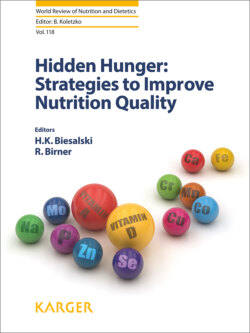Читать книгу Hidden Hunger: Strategies to Improve Nutrition Quality - Группа авторов - Страница 16
На сайте Литреса книга снята с продажи.
Directions for Policy Innovations
ОглавлениеIn most countries, political leaders have verbally and symbolically committed to addressing food and nutrition, but adequate financial resources were not allocated [8]. Low cohesion of the policy community has been identified as a major underlying cause of the low-priority status of food and nutrition. Furthermore, there is still is a lack of structured exchange between science and policy at national and international levels. The world food and agricultural system and the governance of its international dimensions show signs of serious malfunctioning [9, 10]. The incoherent and inadequate response to the acute food price crisis in 2008 was just one indication. What can be done about these constraints?
Nothing less than a re-design of the current global food and nutrition governance system is needed, that means policy innovation at large scale is needed. It would include 2 sets of policy innovations, nutrition getting an organizational home at global level, and science and policy on food and nutrition coming together in a well-defined institutional framework. There should be no illusion that any such policy innovations can be translated into reality in the short run. Political economy forces will prevent that.
Regarding the first, nutrition as a global problem with at least its 3 dimensions of undernutrition, micronutrient deficiencies, and obesity, currently has no well-defined organizational home. Many low-income nation states are not capable to address the nutrition problems effectively by themselves. The recently emerging Scaling Up Nutrition Movement involving more than 50 countries with the UN playing a facilitating role is a promising international effort to overcome this deficiency. Food assistance in failed states and war-affected regions remains a tremendous challenge. A more comprehensive emergency aid mechanism is called for, in which the food and nutrition element covered by WFP remains essential, and where non-governmental actors find improved ways to effectively engage in coordinated ways. The complex nature of the problem calls for an equally complex organizational arrangement at an international level, and not just one entity to handle it all.
Regarding the second, the way policy and science interact related to food, nutrition and agriculture has to be re-shaped as well. Currently, actors on the supply side of scientific information, such as universities and other public or private research organizations, show some interaction and exchange among each other. However, the different actors on the supply side interact with the demand side (e.g., governments, NGOs, or international organizations) mainly on a one-to-one basis. A structured exchange of a more inclusive nature is missing between providers and users of research in the field of food, nutrition, and agriculture. The current and future challenges of food and nutrition security justify a permanent institutional arrangement for this purpose. Re-designing the current system toward an International Panel on Food, Nutrition and Agriculture would provide decision-makers with research-based evidence and enhance the exchange between science and policy (Fig. 3). The set-up of the panel would be partly following the design of the Intergovernmental Panel on Climate Change and applying the principle of separating the provision of science-based assessments from political decision-making, where the latter should be based on facts but takes value judgements on trade-offs into account. Existing organizations and mechanisms would form building blocks of the strengthened and re-designed governance system.2
